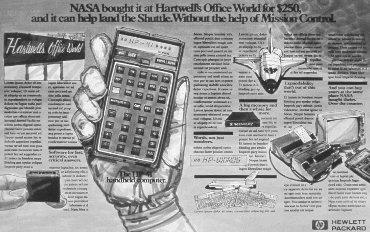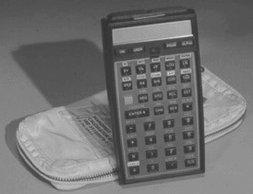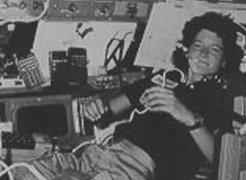HP 41c Handheld Computer
NASA brought a couple of HP 41 from Hartwell’s Office World, an electronic products dealer in Houston, for $250 each. The HP 41 is then programmed to use as a backup land the Shuttle without the help of Mission Control.

Newspaper Advertisement
Six months before the first shuttle flight, former Astronaut Terry J. Hart was asked to find the best calculator for the astronauts. He looked at the TI-59 and the HP 41, the most powerful units available, and decided that the 41’s alphanumeric display capability made it the clear winner.
 Once he decided on the 41, Hart realized he had more than just the handheld scientific calculator NASA had wanted. He started to look for more complex jobs to use it for. The deorbit program is one example. Computation of a deorbit opportunity would have been easy for the on-board computers, but the software for it was never developed.
Once he decided on the 41, Hart realized he had more than just the handheld scientific calculator NASA had wanted. He started to look for more complex jobs to use it for. The deorbit program is one example. Computation of a deorbit opportunity would have been easy for the on-board computers, but the software for it was never developed.
Since the 41s would already be on board as general-purpose calculators, Hart began to develop additional programs for them. CG, the first 41 shuttle program, computes the center of gravity of the orbiter as fuel from the tanks is consumed. Another program, Landtrack, computes the ground track of the shuttle, identifying points of interest on the earth’s surface for observation. These two programs were on board the first two shuttle flights.
The most widely used 41 shuttle program is Deorbit/Alarm/AOS - Acquisition of Signal (AOS), which runs continuously throughout the mission, is important because there is direct communication with ground controllers only during passes over one of 13 earth stations. These passes last about 10 minutes, less if the shuttle does not pass directly over the earth station. AOS beeps at the start of a pass over an earth station and displays the time remaining to loss of signal (LOS).
 The above is an excerpts from a way-cool article from Professional Computing, October / November 1984 Edition. On the first page of the article is a picture of Sally Ride on the Challenger flight of June 1983 and three HP 41s floating in midair. Sally Ride is now a Professor of Physics at UCSD. She initiated NASA’s EarthKAM project, which has enabled thousands of middle school students to take photographs of Earth from a camera aboard the International Space Station.
The above is an excerpts from a way-cool article from Professional Computing, October / November 1984 Edition. On the first page of the article is a picture of Sally Ride on the Challenger flight of June 1983 and three HP 41s floating in midair. Sally Ride is now a Professor of Physics at UCSD. She initiated NASA’s EarthKAM project, which has enabled thousands of middle school students to take photographs of Earth from a camera aboard the International Space Station.
Although the calculators themselves were identical to what anyone could purchase at the time, the software developed for these missions was mission-specific and far beyond what most calculator users might encounter. NASA wrote custom software for each mission and loaded it onto read-only-memory (ROM) modules that plugged into the machines. The crew carried spare modules, so that if there were a hardware failure, one could run the programs on one of the other calculators. The calculators weighed about 200 g (seven ounces), measured 14cm x 7.5cm x 3cm, and of course operated independently of the Shuttle’s main power supply.
Reference:
Hartwell’s Office World
1080 West Sam Houston Parkway North
Suite 120
Houston
TX 77043
USA
Hartwell’s Office World current business actitivies: Computers Document Imaging & Management, Copiers Sales & Service, Copying & Duplicating Equipment & Supplies, Fax Machines, Filing Equipment Systems & Supplies, Microfilming & Imaging Service.